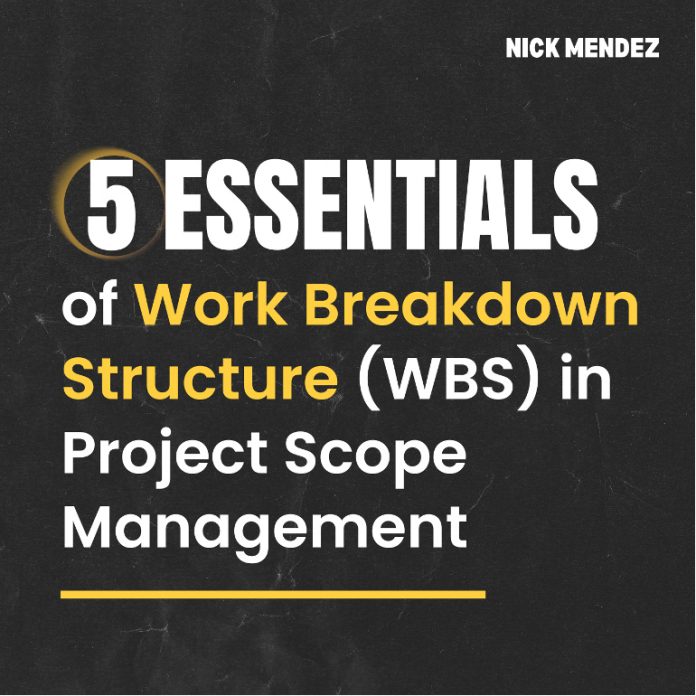Understanding how successful project managers maintain control over complex projects often involves exploring a valuable tool known as the Work Breakdown Structure (WBS). This tool is instrumental in project management, breaking down projects into smaller, manageable components organized hierarchically. By providing clarity and organization, the WBS facilitates effective planning, execution, and oversight by defining all project deliverables and tasks.
In the realm of project scope management, the WBS plays a pivotal role. It comprehensively captures the project’s scope, aids in precise resource allocation, improves risk management and prevents scope creep. With its ability to offer a clear understanding of project scope and deliverables to all stakeholders, the WBS ensures alignment and promotes smooth progress toward project goals.
Exploring the WBS
The Work Breakdown Structure (WBS) is a methodical breakdown of a project into smaller, manageable components and tasks. This structured approach ensures thorough coverage of project elements, leaving no detail overlooked.
WBS is an invaluable tool in the project scope management space. It offers a clear and structured overview of project requirements, simplifying precise planning and resource allocation. Think of it as a detailed roadmap, guiding you through every aspect of your project journey. The WBS aids in monitoring progress, managing scope changes, and maintaining control over project direction. With a well-defined WBS in place, project objectives can be efficiently and effectively achieved, setting the project up for success from the outset.
Understanding WBS Components
The hierarchical nature of a Work Breakdown Structure (WBS) systematically organizes project deliverables into progressively detailed levels, beginning with the overarching project and breaking it down into smaller, more manageable tasks. This decomposition process involves dividing project deliverables into increasingly granular subcomponents, or work packages until they are manageable and executable.
This structured approach enables precise planning, task assignment, and resource allocation, ensuring thorough coverage and precise definition of every aspect of the project. By visualizing the project in this detailed hierarchy, project managers can maintain effective control and oversight, ensuring each component contributes to the project’s overall success. Imagine using a detailed map to navigate a complex journey, one that highlights every turn and destination. That’s the clarity and precision a WBS provides in project management, preventing oversight and enabling smooth execution from start to finish.
Crafting a Solid WBS
Developing a Work Breakdown Structure (WBS) involves several essential steps:
- Start by identifying the project’s major deliverables and objectives, then break them down into smaller, more detailed components and work packages.
- Arrange these components hierarchically to show their relationships and dependencies.
- Utilize tools and techniques such as Microsoft Project, WBS Chart Pro, or other project management software offering templates and visual aids.
Ensure WBS accuracy and completeness by involving stakeholders for input and validation, maintaining a consistent naming convention, and regularly reviewing and updating the WBS to reflect changes in project scope. This meticulous approach guarantees that the WBS comprehensively captures all project tasks and deliverables, establishing a sturdy foundation for effective project management. Keep in mind that each WBS may differ and be unique to individual projects.
Advantages of WBS Implementation
Utilizing a Work Breakdown Structure (WBS) greatly enhances project planning and scheduling by breaking down the project into detailed tasks and deliverables, facilitating precise timeline creation and task sequencing. This level of detail improves resource allocation and management, enabling project managers to identify the necessary resources for each task and allocate them efficiently, avoiding overallocation or shortages.
Furthermore, a well-designed work breakdown structure (WBS) enhances risk management and control. It ensures that risks are adequately managed throughout the project’s duration, highlights potential risk areas at each stage, and enables proactive mitigation strategies. By systematically dividing the project scope into manageable components, the WBS provides a comprehensive overview, simplifying the identification of potential risks and their impact on project outcomes. This proactive approach empowers project managers to implement appropriate risk response strategies early on, reducing the likelihood of costly delays or disruptions later in the project lifecycle.
Overcoming Common Hurdles
Developing a Work Breakdown Structure (WBS) can pose challenges such as insufficient stakeholder involvement, unclear deliverable definitions, scope creep, and oversight of task dependencies. To surmount these obstacles, proactive engagement with stakeholders is vital, ensuring their continuous input and commitment throughout the WBS creation process.
Effective communication and collaboration within the project team are crucial for accurately defining deliverables and aligning them with project objectives. Regularly revisiting and refining the WBS helps mitigate scope creep and identifies any overlooked dependencies. Implementing solid change management protocols and leveraging project management software to monitor revisions and updates further bolsters the WBS’s efficacy, minimizing potential stumbling blocks along the project journey.
Conclusion
The Work Breakdown Structure (WBS) stands as a cornerstone in project scope management, offering a structured framework to define, organize, and oversee project scope. Its hierarchical format facilitates precise planning, resource allocation, risk mitigation, and stakeholder alignment, all of which are vital for project success.
By adhering to WBS best practices—such as thorough stakeholder engagement, clear deliverable definitions, and ongoing review and refinement—project managers can optimize its utility. These practices streamline project execution and proactively address potential challenges, thereby reducing risks and enhancing overall project performance.
Additionally, integrating agile project management best practices can further augment project management approaches.

About the Author – About Nicholas Mendez (Nick Mendez):
Nicholas Mendez (Nick Mendez) is a 26-year-old tech professional with 5+ years of cyber security, and technology project management experience. He earned his PMP certification on April 30, 2023, marking a significant milestone in his career. Since then, he’s written many guest posts and blog posts where readers have received a great amount of value and knowledge to prepare for their PMP exam.
Check out his FREE exclusive top-notch PMP study resources at nickmendez.co and get ready to take your career to the next level!
Sources & Further Reading
https://www.pmi.org/learning/library/work-breakdown-structure-basic-principles-4883
https://www.pmi.org/learning/library/work-breakdown-structure-basics-5919


